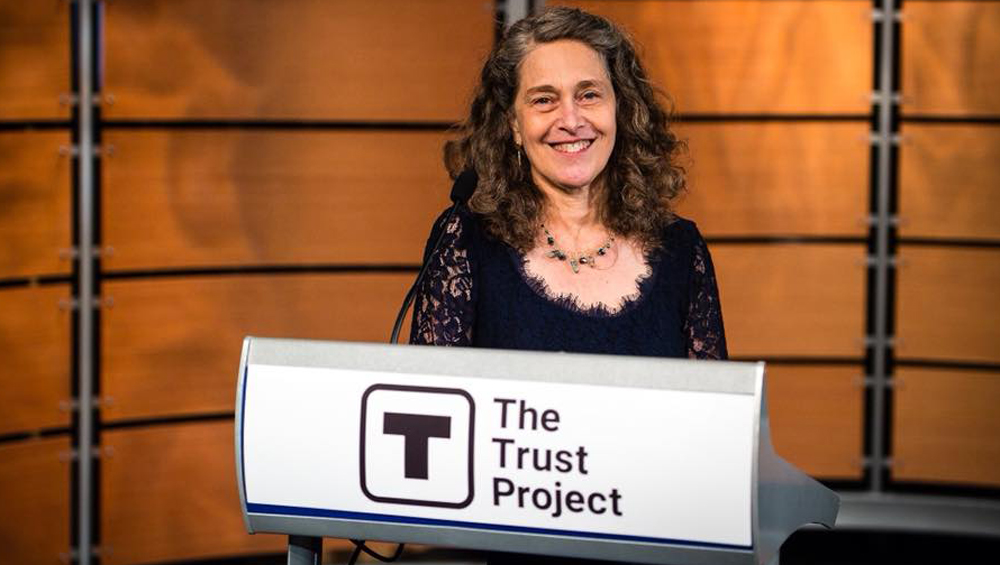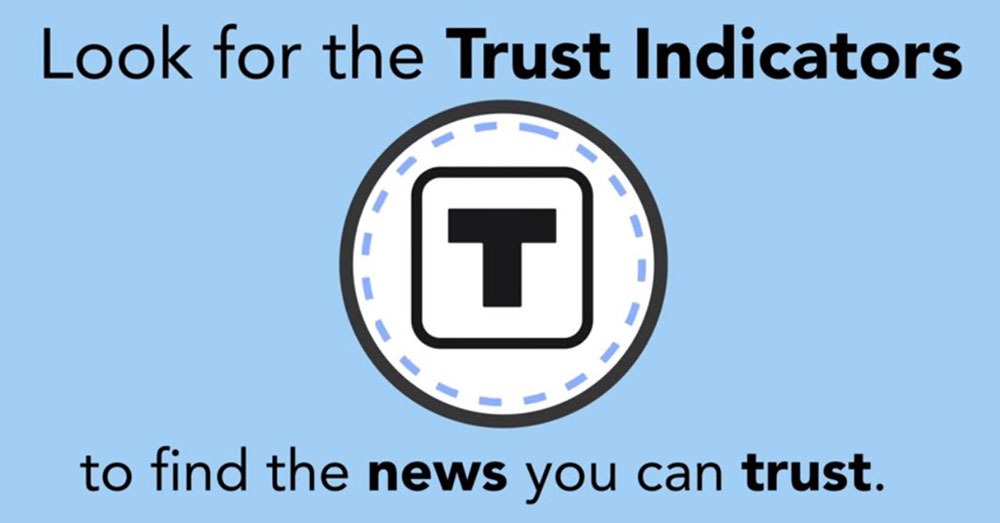
TVN Executive Session | Trust Project Looks To Restore Faith In News

As President Trump began his march to the White House in 2015 with a cry of “fake news,” Gallup polls had already been tracking a decade-long decline in consumer trust of media. That year, the figure cratered, revealing that only about 40% of Americans had “a fair amount” or “a great deal” of trust and confidence in the media to report the news “fully, accurately and fairly.” It was tied for the lowest such rate since Gallup had begun keeping track of such data in 1997, and represented a 10% decline since 2005.
The trend prompted journalist and former director of Santa Clara University’s journalism ethics program Sally Lehrman to found The Trust Project, a nonprofit, in 2014, where she currently serves as CEO. It’s an international consortium of more than 120 news organizations working toward greater transparency and accountability. Their efforts have manifested into the Project’s eight “Trust Indicators,” a set of standards news outlets can follow to prove they are worthy of consumer trust.
A number of news organizations, including broadcasters like Hearst, Tegna, BBC and Sky News have displayed their adoption of the Indicators on their websites with hopes of retaining the public’s trust. TVNewsCheck’s Michael Stahl spoke with Lehrman about The Trust Project, the dangers within journalism these days, and what news groups can do better if they want to earn back trust.
An edited transcript.
What motivated the founding of the Trust Project?
In the late 90s, I brought together some senior news executives that had started working in what we called “new media” at the time. They were really concerned about how ethics and quality would be affected by digital technology. Then, in 2013, while I was at Santa Clara University, I brought back many of the same people who had risen in the field, plus a few others, and they were still talking about the same thing. They were worried about the digital environment undermining our ethics, undermining quality, but now they had evidence.
I thought why are we allowing this digital space to control us in journalism? Why can’t we flip the picture and use the digital space to improve and underline and support the quality, rather than push us down to the lowest common denominator?
We did interviews with the public, talked to people across race, class, gender, generation and geography, and asked them what it is they valued in the news and when did they trust it. We took all that and worked in workshops with people from a hundred different news companies and committed to marrying what we know users are looking for with what we know are journalistic values and fundamentals.
We came up with a set of 37 different Trust Indicators, and then through a process of discussion with the different tech platforms, with one another, with users, we narrowed it down to the eight that you see today.
Where does the Trust Project’s funding come from and do you have a dedicated staff?
Our funders are Craig Newmark Philanthropies, Democracy Fund, Google, Facebook and Knight Foundation. We have people who are responsible for helping to implement the Trust Indicators and we are hiring a full-time staff for that, and then we have a review group that is all made up of our existing news partners.
What are some of the most important Trust Indicators that broadcasters should consider?
They’re all important, but one that we’re still working on deals with something that was important to users on a local level. They want the people presenting the news to them to understand their community, their regional demographics. They wanted to know the difference between somebody who had flown in, let’s say, to cover the caucuses, and somebody who was locally based and understood the community.
We hear a lot from the public [about] the label of news versus analysis versus opinion or paid content. There’s a lack of consistency on the part of everybody, including broadcast, in describing paid content. So is it branded content? Is it advertiser content? What’s the line between supported content and actual advertiser content? We have had a working group that has come back to help make those distinctions.
How can broadcasters potentially get involved with this Trust Project?
We are platform agnostic and have an application system. Broadcasters can let us know that they want to participate. We’ll do an initial call to explain what would be involved, and then we send them a questionnaire. Their answers go through a review committee and then they get started. They get put into a cohort and they work with news organizations across other media to implement these Trust Indicators on their sites.
Every company that agrees to participate [must] implement all eight indicators on their website before they can use the Trust Mark logo. That means they have gone through the compliance check. For now, Trust Indicators are just posted on websites; it’s not something that you would be able to broadcast, although we are an evolving project and that is going to be a next step.
 Where have you seen these standards implemented? What’s an example of a success story where your group’s goals have manifested?
Where have you seen these standards implemented? What’s an example of a success story where your group’s goals have manifested?
I was just talking to the executive editor of a newspaper company in the U.K., and they said, “We have been working with the Trust Project for several years and it’s really changed our practices internally. We knew we had these standards in place, but we weren’t talking about them actively in the newsroom. That’s what is happening now, and we’re showing them to the public as well.”
The Washington Post has done a really good job with the design and showing things like our author information or the standards in a really clear way. So has Toronto Star, which also has a really nice UX. Broadcast-wise, I know both Hearst and Tegna have put a lot of attention toward it.
Do you recruit companies to implement the indicators?
It’s a mixture. We started out recruiting because nobody knew about us. Now we get a lot of inquiries and we try to build a diversity of sites in each cohort: You get some international diversity, broadcast, digital native, legacy text. We also want to make sure we get the regionals and locals. In this last round we had quite a few regional groups, and in our new launch, which we’ll announce in about a month, we’ll have a new group of news sites.
I hope we will get more applications, but I am also paying attention to the gaps. One of the relative gaps is in broadcast. They have done wonderful jobs – Tegna, Hearst – but there’s clearly a lot more that could be done.
How important is it to have Facebook and Google as partners? What have they brought to the table, and what message does their involvement send to their users, the general public and even legislators?
We work closely with them, but I consider them external partners. Part of what we do is we collaborate with these external partners and also sometimes hold them accountable. So the importance of having them involved cannot be overstated because this is where people are getting their news.
It also helps them, particularly the search engines, with providing relevant news at the right time. That gets to that local designation: If you are an expert in a local story and something is happening in your region and you are there first, then through the Trust Indicators, over time, you are more likely going to be the one that Google surfaces. Our aim is to make the local experts the ones that Google surfaces, as opposed to some bigger-name organization that flies into the region and covers the story.
We are focusing with Facebook mostly on user understanding. Facebook shows users, in its little context button it links to, certain standards of a news organization, their ethics and their corrections policies. They are all part of the “Best Practices” Trust Indicator.
So through that work we are building media news literacy and helping people understand what it is that makes journalism distinct. Facebook is amplifying that work through specifically using our Trust Indicators and linking to the Trust Project.
What can news outlets do better to report this election cycle accurately while garnering greater consumer trust?
There are a lot of things that can be done at the reporter level. We heard over and over in our user interviews that people understand journalists aim to be impartial, but everyone has an agenda. So it’s showing our agenda, [which is] to serve the public. It’s not to serve a particular candidate or particular party.
We show that in part through all these Trust Indicators, that we are being transparent about who owns us and what’s behind the work, but also in the way we communicate with the public and the way we report stories. [It’s] being sure to be inclusive in our reporting. Distinguishing opinion, analysis and journalism from news is going to be critical.
In your time in media, why do you believe public trust in news has dwindled? Has that degradation been earned or has it more just been propagated by certain political figures?
The decline in trust started about when we began moving to the internet. It was not a bad thing that we started going digital, but it challenged our practices and our strategies and sometimes we took a wrong turn.
There were a lot of things done in the early days that were just to get traffic. That was a mistake because people saw through that. And then there was this whole thing of getting a more opinionated voice because we thought that was going to help. In broadcast, we started to see so many journalists become pundits and it was hard to tell the difference.
Should journalists have latitude to express their personal opinions that they wouldn’t otherwise express on air or in written stories?
That is up to the news organization. It is important to be really clear. The more we express opinions, the more we confuse the public, and each individual news organization has to set policies about this.
How alarmed are you by some of the censorship initiatives we are seeing spring up in other countries? Is there a concern that the U.S. could replicate some of these prohibitions?
The one thing that I feel we as journalists can have opinions about is good journalism, the First Amendment and access to information. There are a lot of good organizations that spend a lot of time defending journalist access to information. We just have to continue that effort, always.
































Comments (0)